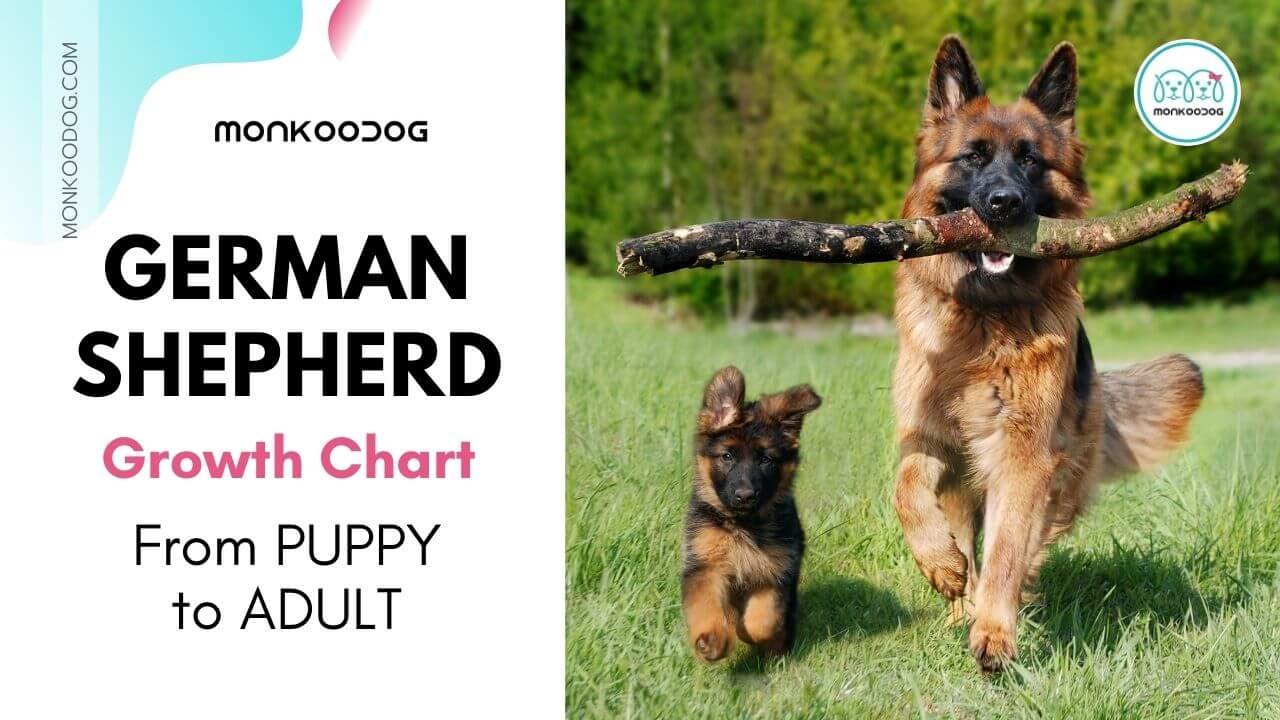Keeping track of your pup’s growth has become an obsession for most dog owners. Though tracking growth is a good thing as it can help to spot any growth defects early on and take the required steps to overcome it, it can also become a negative engagement as not all dog owners realize that the growth charts only display the average size numbers and it is completely okay for your dog to fall a little above or below that.
German Shepherd breed information
German Shepherds or Alsatians, as they called in the US, are one of the most popular dog breeds in the world. As the name signifies, they first originated in Germany in the late 19th century and were used to overlook herds of sheep. They are now being extensively used for guarding, tracking, and for several police and military purposes given their high intelligence and obedience. The best part about GSD is that they are great working dogs as well as companion dogs. Here are some unknown facts about the German Shepherd breed that you might never know.
As the millions of GSD owners would be hoping for some information that will assist them with their puppy’s growth and first-timers especially, will be nervous and want to know if their puppy is doing well, we have this blog for you.
Read on to know everything you need to know about a German Shepherd puppy’s growth.
What is the usual growth period for GSD?

The GSD puppy begins growth from birth and goes on until 36 months. You must note that, while growth happens until 36 months, the rapid growth phase is between 3-6 months. During this phase, you will notice that your pup seems to be growing exponentially each day!
However, some pups might reach full growth before 36 months while some may even take a few months extra and you need to know that it is completely alright.
You need to know that GSDs are sexually dimorphic so males and females have slightly different size categories.
GSD Growth Charts
Growth charts for GSD will help you keep track of your puppy’s growth by referencing the numbers on the chart. However, you need to worry about small differences in size with the chart values as each puppy is different. You can check out NOW your German Shepherd puppy’s growth here in this Puppy weight calculator. You can however note if your puppy reaches his developmental milestones like developing teeth within the mentioned time frame.
Note that there are several growth charts available online and consult only with verified sources.
GSD Growth Stages
The overall growth and development of a GSD puppy can be broken down into five major stages. During each stage, the puppy begins to develop certain features and also shows changes in his behavior.
The changes at each stage will guide you on what to provide for the puppy at that point and also check if your puppy has reached his developmental milestone
1. Neonatal stage: 3 weeks
In this stage, the puppy is heavily dependent on the mother as they are blind and deaf. Towards the end of this stage, they start acknowledging other members of the litter and even start to ‘play’ with them.
Milestones
- he puppy begins crawling after one week
- Ears and eyes start opening after 10 days and fully open at 2 weeks
- The first signs of teeth begin showing at 2 weeks
- Can eliminate by themselves in 2 weeks
- Begin walking at two weeks
2. Socialization stage: 3-12 weeks
Though this is the stage where the puppies begin socializing with the other puppies and is also the best time to start spending time with humans. Though they interact with others, it is important that they stay with their mother and she teaches several social skills to them.
In case puppies are removed from their mother at this stage, they may have difficulty regarding social activities later on. They develop the fear response after 6 weeks and this is a very crucial point in socialization. This is the time they can bond with their masters.
During this time, they also begin teething which will cause a lot of biting. They are also very curious at this stage and love exploring.
Milestones
- Start walking well at 3 weeks
- Ears stand upright
- Socialization
- Develop almost all the teeth by 4 weeks

3. Juvenile stage: 3-6 months
During this stage, you can begin training your puppy. You can begin with potty training, as it is the most important one and also start with a few basic commands like ‘Yes’ or ‘No’.
Most of their development is already done and from now on, they will start increasing in size. It is also the ideal time to separate them from their mothers and meet their new family.
Milestones
- Develop a full set of baby teeth at 3 months
- Gain enhanced motor skills
- Adult teeth begin growing at 4 weeks
4. Sexual Maturity stage: 6-16 months
If you have a female dog, then she must have had her first season of ‘heat’ as females usually reach sexual maturity by 6 months. Males reach sexual maturity after 7 months.
If you want to spay or neuter your dog, this is the time to do it and if you want your dog to breed, you need to make sure it reaches a proper size and bone structure.
Milestones
- Develop a full set of adult teeth by 6 months
- Attain sexual maturity
- Develop belongingness if they are in a pack
5. Adult stage: 16-36 months
This is when the dog loses his childishness and behaves like a mature adult. As he starts acting mature, you can start with basic obedience and behavioral training.
It is also very crucial that your dog gets a lot of exercises and natural healthy food from now on.
Milestones
- Females reach full growth around 2 years
- Males reach full growth around 2.5 to 3 years
Once this stage is complete, the dogs reach their adult weight which stays on for the most part of their lives.
The Average Adult Weight of
- Males – 30-40 kg
- Females – 22-32 kg

Factors that Influence Growth
The average lifespan of a GSD is more than nine years. However, the growth and life of a German Shepherd puppy may be subject to change due to any of the following factors.
- Parents
Genetics plays an important role with dogs too. The size and weight of the parents greatly influence the growth of the puppies. In addition to this, German Shepherds are also prone to several inheritable diseases like dysplasia in hip or elbow, panosteitis, pancreatic disorders, and several allergies. Sometimes, they might also have issues with angulation and proper movement.
- Breeding line
Sometimes, their growth or size might also depend on the reason they were bred for – as a show dog or a working dog. The show dog line is usually thinner and also has a sloped back with shorter hind legs while working dogs are bigger with straight backs.
- Nutrition
What do you feed your GSD? Does he get a proper balanced diet? Do you update his diet plan with his developmental requirements?
All these matter and influence growth as merely any kind of food will not cause optimum growth. Most pet owners stick solely to dog food. While this is fine for the most part of the week, you need to substitute it with a nutritious and fresh home-cooked meal at least 3-4 times.
A common mistake that most GSD owners make is overfeeding. As the German Shepherd is a large breed, they mistake that large portions of meals must be given. This is very wrong as overfeeding large breeds can cause osteoarthritis or dysplasia.
YES – too much calcium or phosphorus can also cause joint disorders.
To avoid this, take a look at the popular feeding schedules for GSD or consult with your vet to create your own schedule.
- History of Illness
In case your puppy has a history of multiple illnesses, then it is bound to affect his growth cycle. He might not reach the average growth size and might weigh a little less than usual.
- Environment
Yes, the environment where the puppy grows also influences his growth. For example, puppies that are grown in a very confined environment with no room for physical activity might be easily prone to dysplasia which might cause lameness.
Apart from this, it is crucial that your GSD is happy, loved, and satisfied. As they are a highly active breed, some exercises or activity it is highly recommended to avoid getting them bored, especially in these lockdown times, which might cause mental issues like depression or even cause aggressiveness and restlessness. These do not mean well for the overall development of the dog, so you need to take up the responsibility of providing a holistic nurturing environment.
How can I make my German Shepherd Bigger?
Based on the above factors, there are possibilities that your dog might fall below the average size that is mentioned. As a result of this, owners try to maximize feed as an attempt to make them grow bigger. This is very dangerous as GSDs are rapidly growing dogs and tampering with their feeding schedules will cause skeletal disorders. So, as we’ve said, the size of your German Shepherd dog is totally dependent on its breed and pedigree. Within those limits, you can achieve maximum by proper diet n exercise and good physical n mental health.

